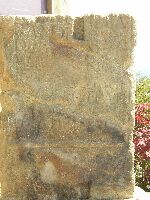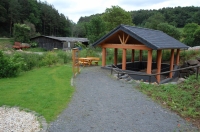



Protection and conservation
Protection
After construction there arose many external threats for aqueduct structures, both below and above surface, even from nature: vegetation like the roots of trees could harm channels, bridges and other parts. The same counts for water itself: the destructive power of water is, even today, widely accepted. After heavy rains the water from the slopes of hills and mountains could undermine or even wash away the conduit so sometimes special measures were taken to divert unwelcome run-off water. For an example see the measures taken near Breitenbende, to prevent damage to the aqueduct of Köln / Cologne (Germany).That os why sometimes cippi (border stones, singular: cippus) were placed along the course of an aqueduct, usually about 240 Roman feet (71 m) apart, indicating that within 15 Roman feet (4,5 m) from an arcade and 5 Roman feet (1,5 m) from a subterranean aqueduct channel, it was prohibited to realize any activity or construction.
Famous is the inscription CIL 13.1623, the so-called 'Pierre de Chagnon', stating that "By authority of Caesar Traianus Hadrianus Augustus nobody has the right to work, to sow or to plant in this area which is earmarked for the protection of the aqueduct", a protective measure along the Gier aqueduct of Lyon (France).
In paragraph 129 of his treatise De Aqueductu Frontinus makes mention of detailed regulations for protection of the water infrastructure.
Earthquakes were not an unusual phenomenon in some parts of the Roman Empire and posed a threat to aqueducts. There are quite a few known examples of serious damage to aqueducts by earthquakes like at Crete and Sicily. Several years ago the editor of a journal was asked to refrain from publishing an article about landslides in central Italy based on displacement of a Roman aqueduct: potential home buyers would refrain from purchasing one of his apartments in this area.
Frontinus, one of the major written sources in aqueduct studies, noted the massive scale of illegal tapping of the aqueducts of Rome, which did not only led to an decrease of water for the city involved, but also to damage to the conduits or pipes and subsequent leakages. Often - so is his complaint - his own 'water men' were involved in these illegal constructions. In order to prevent more fraud, Frontinus ordered the use of a calix, a bronze pipe of limited length - bronze difficult to distort but expensive - but of standard size directly connected to the castellum (distribution basin) as part of the water supply line to private users.
Conservation
Even nowadays the present remains of the ancient aqueducts (and other structures from antiquity) suffer from almost the same hazards: damage caused by (rain) water and destructive vegetation but also from vandalism and the activities of project developers: in some countries an adequate juridical framework is missing or the laws are not or only partly maintained, often in favor of economic interests.On the other hand, many aqueduct remains receive special attention by means of leaflets, walking tours, and information panels, serving many educational purposes, raising public awareness and interest in history and ancient technology.